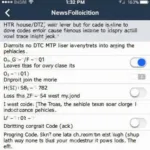The 2004 Subaru Outback is a reliable vehicle, but like any car, it can experience issues, including problems with the OBD2 port. Troubleshooting 2004 Subaru Outback OBD2 port problems can sometimes be tricky, requiring a methodical approach to identify the root cause. This article provides a comprehensive guide to diagnosing and fixing these issues, helping you get back on the road quickly. We’ll cover everything from common causes to advanced troubleshooting techniques.
Common 2004 Subaru Outback OBD2 Port Problems
Several issues can arise with the OBD2 port on a 2004 Subaru Outback. These range from simple connectivity problems to more complex electrical faults. Understanding the common problems is the first step towards a solution.
- Loose or Damaged Connector: The OBD2 connector itself can become loose or damaged over time. This can prevent a proper connection with your scanner.
- Blown Fuse: The OBD2 port is typically connected to a fuse. A blown fuse can completely cut off power to the port.
- Wiring Issues: Damaged or corroded wiring can disrupt the communication between the port and the vehicle’s computer.
- Faulty OBD2 Scanner: Sometimes, the problem isn’t with the port itself, but with the scanner you’re using.
Where is the OBD2 Port on a 2004 Subaru Outback?
The OBD2 port in a 2004 Subaru Outback is typically located under the dashboard, on the driver’s side, near the steering column. It’s a trapezoidal connector with 16 pins. Check your owner’s manual if you’re having trouble finding it. If you’re still unsure, check out our helpful resource on 2000-2004 subaru outback obd2.
Troubleshooting 2004 Subaru Outback OBD2 Port Issues
Once you’ve identified a potential problem, follow these steps to troubleshoot:
- Check the Fuse: Locate the OBD2 port fuse in your vehicle’s fuse box (consult your owner’s manual). Inspect the fuse visually and use a multimeter to confirm if it’s blown. Replace it if necessary.
- Inspect the Connector: Examine the OBD2 port for any signs of damage, such as bent pins or loose connections. Try gently straightening any bent pins with a small pick or needle.
- Test with a Different Scanner: If possible, try connecting a different OBD2 scanner to the port. This will help determine if the problem is with the port or your original scanner.
- Check the Wiring: Visually inspect the wiring leading to the OBD2 port for any signs of damage or corrosion. You might need to remove some panels to access the wiring fully. You can find more information on OBD2 codes at subaru obd2 fault codes.
Advanced Troubleshooting for 2004 Subaru Outback OBD2 Port Problems
If the basic troubleshooting steps don’t resolve the issue, you may need to delve deeper.
- Check for Power at the Port: Use a multimeter to check for power at the OBD2 port. This will help determine if there’s an electrical issue.
- Inspect the DLC Connector: The Data Link Connector (DLC) is the internal part of the OBD2 system. Issues with the DLC can prevent communication with the scanner. Accessing the DLC may require removing parts of the dashboard.
- Consult a Professional: If you’re unable to diagnose the problem yourself, it’s best to consult a qualified mechanic or auto electrician. They have the expertise and tools to identify and fix complex electrical issues. Thinking about clearing those pesky codes? Our guide on erasing codes obd2 can help.
What if I can’t connect my scanner to the port?
If your scanner won’t connect, check the fuse, the connector, and try a different scanner.
Is there a specific fuse for the OBD2 port?
Yes, consult your owner’s manual for the exact location of the OBD2 fuse.
Can I fix the wiring myself?
If you’re comfortable working with car electrics, you can attempt to repair damaged wiring. However, for complex issues, consult a professional.
How much does it cost to repair an OBD2 port?
The cost of repair varies depending on the specific problem. A simple fuse replacement might only cost a few dollars, while more extensive wiring repairs could be more expensive. Curious about when OBD2 became standard? Check out our resource on the first year obd2.
Conclusion
Troubleshooting 2004 Subaru Outback OBD2 port problems can be a straightforward process if you follow a systematic approach. By understanding the common causes and following the troubleshooting steps outlined in this article, you can often resolve the issue yourself. However, for complex electrical problems, it’s always best to seek professional assistance.
FAQ
- Q: What are the most common 2004 Subaru Outback OBD2 port problems? A: Common issues include a loose or damaged connector, a blown fuse, wiring problems, and a faulty OBD2 scanner.
- Q: Where is the OBD2 port located on a 2004 Subaru Outback? A: It’s typically located under the dashboard, on the driver’s side, near the steering column.
- Q: How can I check if the OBD2 port fuse is blown? A: Locate the fuse (consult your owner’s manual) and visually inspect it. Use a multimeter to test for continuity.
- Q: What should I do if I suspect a wiring problem? A: Visually inspect the wiring for damage. If you’re comfortable with car electrics, you can attempt repairs. Otherwise, consult a professional.
- Q: When should I consult a mechanic about OBD2 port problems? A: If you’ve tried the basic troubleshooting steps and the problem persists, it’s time to seek professional help.
- Q: Can a bad OBD2 port prevent my car from starting? A: A faulty OBD2 port itself usually won’t prevent the car from starting, but underlying electrical issues that affect the port could.
- Q: How can I prevent future OBD2 port problems? A: Regularly inspect the port and connector for damage and keep the area clean and dry.
Need help? Contact us via WhatsApp: +1(641)206-8880, Email: [email protected] or visit our office at 789 Elm Street, San Francisco, CA 94102, USA. Our customer support team is available 24/7.
